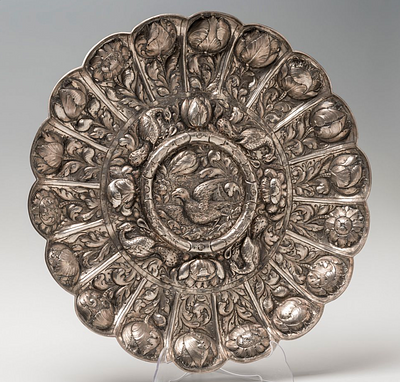Spanish school; late fifteenth century. "Virgin and Child".
Lot 85
About Seller
Setdart Auction House
Carrer Aragó 346
Barcelona
Spain
Setdart Subastas was born in 2004 and is currently the first online art auction in Spain with solidity, prestige and reliability guaranteed by our more than 60,000 users. Setdart has a young, dynamic and enterprising team ready to successfully manage the purchase and sale of art works through custom...Read more
Categories
Estimate:
EUR€3,000 - EUR€3,500
$3,225.81 - $3,763.44
Absentee vs Live bid
Two ways to bid:
- Leave a max absentee bid and the platform will bid on your behalf up to your maximum bid during the live auction.
- Bid live during the auction and your bids will be submitted real-time to the auctioneer.
Bid Increments
| Price | Bid Increment |
|---|---|
| EUR€0 | EUR€10 |
| EUR€200 | EUR€25 |
| EUR€500 | EUR€50 |
| EUR€1,000 | EUR€100 |
| EUR€3,000 | EUR€200 |
| EUR€5,000 | EUR€500 |
| EUR€10,000 | EUR€1,000 |
| EUR€20,000 | EUR€2,000 |
| EUR€50,000 | EUR€5,000 |
About Auction
By Setdart Auction House
Jul 13, 2021
Set Reminder
2021-07-13 07:00:00
2021-07-13 07:00:00
America/New_York
Bidsquare
Bidsquare : DECORATIVE ARTS XV-XIX
https://www.bidsquare.com/auctions/setdart-auction-house/decorative-arts-xv-xix-7201
Setdart Auction House sofia@setdart.com
Setdart Auction House sofia@setdart.com
- Lot Description
Spanish school; late fifteenth century. "Virgin and Child". Carved wood, polychromed and gilded. It presents faults in the hands, loss of polychrome and xylophagous damages. It has elements of the seventeenth century. Measures: 55 x 25 x 17 cm. The Virgin standing with the Child in her arms is a theme that has its origin in the Gothic period, and comes directly from the Byzantine Odigitria. Its name means "She who shows the way", the divine way, and hence, in Byzantium, and also in the West at first, she points to the Child with her right hand. As we see here, with the advance of naturalism at the end of the Gothic and already in the Renaissance, this symbolism will be replaced by a more human relationship between mother and Child, and we will see representations like this one, in which the Virgin and Child, although not yet looking at each other, are represented as a mother holding her little son in her arms. On the other hand, at first, the representation of the Virgin standing with the Child in her arms was placed in the mullions, forming part of the architecture, like most Gothic sculpture. However, it must have enjoyed great success among the faithful, so that from the late twelfth and early thirteenth centuries they began to be made in small format, free-standing and in different materials. It will be then when they begin to be not Odigitrian Virgins, but more maternal representations. At first they were made mainly in France, and from there they were exported to the rest of Europe; the models would become classics, repeated over and over again. In this case we see reflected this devotional evolution, which tries to show the faithful the maternal filial relationship existing between the two protagonists. Both look at each other and the child seems to be lulled in the mother's arms, although this gesture is not clearly defined by the current faults of the carving. Regarding the aesthetics of the piece, it should be noted that the work retains characteristics of the Gothic, such as the use of angular folds, or the dispersion of the mantle with the crown, however, the posture of both the Virgin and Child, show some dynamism that connects directly with aesthetic precepts that will be developed in later times.
- Shipping Info
-
In-house shipping available. Please inquire at admin@setdart.com.
-
- Buyer's Premium



 EUR
EUR CAD
CAD AUD
AUD GBP
GBP MXN
MXN HKD
HKD CNY
CNY MYR
MYR SEK
SEK SGD
SGD CHF
CHF THB
THB
















